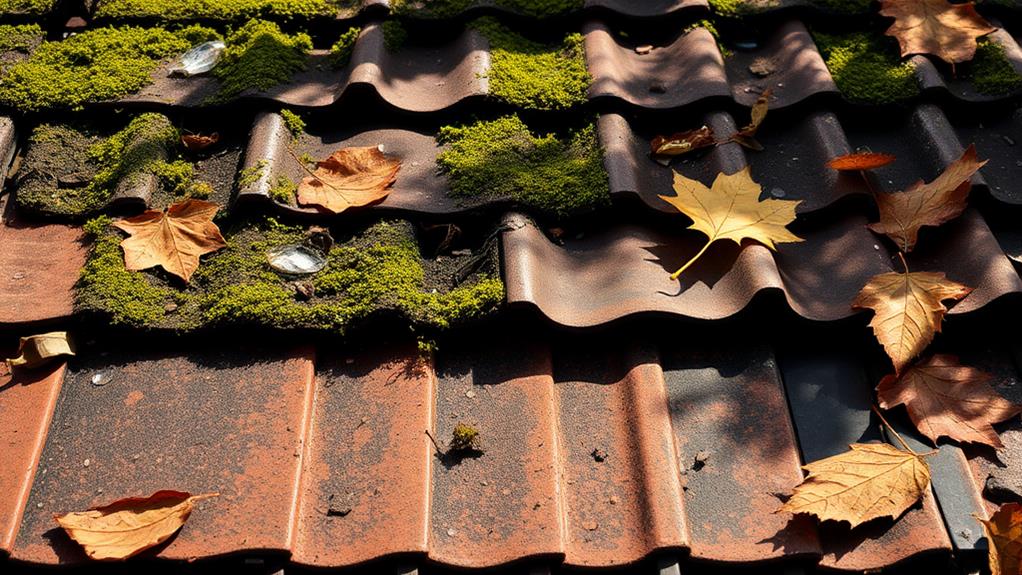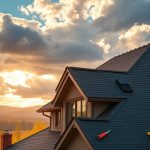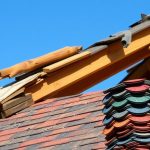The lifespan of a residential roof fluctuates considerably based on several pivotal factors, chiefly the quality of materials used, prevailing weather conditions, and the rigor of maintenance practices. High-quality materials such as slate, metal, and premium composites often resist environmental stresses more effectively, offering durability even under extreme weather patterns. Conversely, cheaper materials may degrade quickly, leading to frequent repairs. Regular maintenance, including inspections and clearing debris, plays a crucial role in extending a roof's life by preventing minor issues from escalating. Comprehending these nuances guarantees a strategic approach to maximized roof longevity, opening pathways to further insights on optimizing roofing solutions.
Roofing Highlights
- The lifespan of a residential roof varies; asphalt shingles last 20-30 years, while slate and metal can exceed 50 years.
- High-quality materials and professional installation significantly enhance the durability and service life of residential roofs.
- Regular maintenance, including inspections and timely repairs, is crucial to extending a roof's longevity.
- Climate conditions, such as temperature fluctuations and precipitation, profoundly impact the lifespan of roofing materials.
- Energy-efficient roofing systems can provide additional longevity benefits by reducing thermal stress and moisture retention.
Why Roofs Degrade

The degradation of residential roofs can be attributed to several key factors, including the relentless effects of weather conditions, the inherent quality of roofing materials, and the pivotal role of regular maintenance. Adverse weather phenomena such as heavy rain, snow, and high winds contribute greatly to the wear and tear on roofing structures, accelerating their decay over time.
Additionally, the longevity of a roof is heavily influenced by the quality of materials used in its construction, as well as consistent maintenance practices that help mitigate potential damage and preserve structural integrity. For residents in the Denver, Colorado metro area and surrounding cities, having a dependable local roofing company is essential to guarantee ideal lifespan and performance.
Weather Impact on Roofs
Weathering is a significant factor contributing to the degradation of residential roofs. The impact of weather on roofing is unmistakable, manifesting in diverse forms such as temperature fluctuations, precipitation, and wind. Each element plays a distinctive role in eroding the structural integrity and aesthetic appeal of a roof over time.
Temperature variations cause materials to expand and contract, leading to cracks or warping, especially in regions experiencing extreme seasons.
Precipitation, including rain, snow, and hail, accelerates wear by penetrating seams, gradually weakening the roof's water-tight capacity. Persistent moisture can result in the growth of moss and algae, which not only disfigure the roof but also hold moisture against it, exacerbating decay.
Windy conditions, meanwhile, pose a direct risk by loosening or tearing shingles, potentially leading to immediate damage that demands urgent attention. These elements are not isolated; rather, they are interconnected forces that, when combined, can dramatically reduce the period of service a roof can provide.
Understanding the destructive potential of weather conditions encourages homeowners to take preventive measures. Regular inspections and maintenance maintain roofs' ability to withstand the relentless forces of nature, preserving their structural soundness and the sense of security they offer.
Material Quality Factors
Material quality plays an essential role in determining the longevity of residential roofs. Roofs are subject to varying degrees of environmental exposure, and the integrity of the materials utilized in their construction profoundly impacts their resistance to deterioration. High-quality roofing materials, such as slate, metal, and certain premium composites, are engineered to withstand extreme weather conditions, physical stress, and time's naturally erosive effects, providing robust protection and an extended service life compared to lower-grade counterparts.
The degradation of roofing materials can be traced to several intrinsic factors. The permeability and resilience of these materials influence their capacity to repel UV radiation and moisture intrusion—key agents of deterioration. Additionally, the composition of the materials dictates their vulnerability to thermal expansion and contraction, which can lead to cracking or warping over time. Inferior materials may succumb to these effects prematurely, shortening the roof's lifespan and necessitating costly replacements or repairs.
Quality is not merely a matter of initial investment but a long-term commitment to safeguarding one's home. It fosters a sense of security and community, knowing homes are protected by durable rooftops that complement a well-knit neighborhood. A discerning choice in material quality not only preserves individual residences but collectively enhances neighborhood appeal and resilience.
Maintenance Importance
Proper maintenance is pivotal in preventing premature degradation of residential roofs, particularly within the diverse climates they endure. The relentless assault by natural elements—ranging from scorching sunlight, heavy rainfall, to freezing temperatures—imposes significant stress on roofing materials. Consequently, consistent maintenance emerges as an indispensable ally in prolonging the roof's lifespan and safeguarding its performance.
Routine inspections facilitate the early detection of potential issues such as leaks, broken shingles, or debris accumulation. By addressing these concerns swiftly, homeowners can thwart more severe damage and the substantial costs associated with major repairs. Additionally, cleaning gutters and removing moss or algae growth can prevent moisture retention, which otherwise might compromise the roof's structural integrity. This proactive approach extends the communal understanding of stewardship, enhancing a sense of security and care within the neighborhood.
Furthermore, employing professional roofing services for maintenance contributes to a thorough evaluation of the roof's health. These experts, equipped with specialized knowledge and tools, offer invaluable insights and solutions tailored to the specific roofing material and local climate. When integrated into a routine, such initiatives guard the roof as a sturdy and sustainable component of the home.
Benefits

Investing in a roof with a longer lifespan offers multiple benefits, including enhanced energy efficiency that can lead to reduced utility costs, and an increase in property value, making it a wise financial decision for homeowners.
A roof with an ideal design can also contribute to the overall longevity and efficiency of your home. Understanding the roof installation process and selecting the right materials can further maximize these benefits.
Additionally, durable roofing materials require less frequent maintenance, consequently reducing the long-term expense and effort associated with upkeep. Collectively, these advantages not only contribute to a more sustainable and cost-effective home environment but also enhance the overall appeal and functionality of your property.
Enhanced Energy Efficiency
Upgrading to an energy-efficient roof offers significant benefits, particularly by reducing energy consumption and lowering utility costs. With climate change urging the world towards sustainability, adopting roofing solutions that minimize energy wastage aligns with conscientious living.
Energy-efficient roofs are designed using materials that reflect more sunlight and absorb less heat, which effectively stabilizes indoor temperatures. This stabilization reduces the load on heating and cooling systems, resulting in tangible savings on energy bills and contributing to a smaller carbon footprint.
The construction of such roofs often includes advanced technologies like cool roofing options or solar reflectance, extending beyond mere insulation enhancements. These roofs provide superior thermal regulation, especially in climates experiencing extreme temperatures through varying seasons.
Additionally, employing energy-efficient roofing materials fosters a culture of environmental stewardship and embraces a community of forward-thinking homeowners. Connection through shared values of sustainability reinforces community bonds, promoting inclusion in discussions about energy responsibility and future-oriented living practices.
As energy efficiency becomes increasingly integral to modern housing, this adoption not only supports personal economic advantages but also engenders a collective movement towards greater self-sufficiency, enhancing the overall welfare of neighborhoods committed to responsible living.
Increased Property Value
Beyond the significant energy savings, an energy-efficient roof can substantially increase a property's market value. By investing in a high-quality, sustainable roofing solution, homeowners not only enhance the aesthetic appeal of their homes but also attract potential buyers who value longevity and reduced environmental impact. This growing demand for greener living solutions reflects collective consciousness towards sustainability within our communities, reinforcing a shared sense of responsibility toward the planet.
Financially, properties with energy-efficient roofs are highly attractive in the real estate market, appealing to a broad range of buyers—from conservation-minded millennials to seasoned homeowners who recognize cost savings over time. Prospective buyers often perceive such properties as future-proof investments, minimizing uncertainty associated with rising energy prices and stricter environmental regulations. This perception translates into tangible financial value, often allowing sellers to command higher premiums.
Moreover, appraisers and realtors acknowledge energy-efficient roofing materials during home assessments, frequently highlighting them as valuable assets. Communities are increasingly valuing resilience alongside comfort, viewing homes with energy-efficient roofs as part of a more sustainable lifestyle. In this manner, these properties foster a collective pride among homeowners, framing a shared vision of environmental stewardship and fiscal prudence.
Reduced Maintenance Costs
A notable advantage of energy-efficient roofing systems lies in their reduced maintenance costs. These systems are specifically designed to withstand severe weather conditions, resist wear and tear, and minimize the need for frequent repairs, consequently providing homeowners a long-term financial benefit. By using durable materials and innovative technologies, energy-efficient roofs considerably lower the chances of damage from elements such as wind, rain, and heat. Consequently, they reduce the costs associated with routine maintenance and unforeseen repairs, offering peace of mind to homeowners who desire reliability and longevity from their investments.
Moreover, energy-efficient roofing often includes advanced features such as reflective surfaces to mitigate heat absorption, which adds to their durability and efficiency. This not only extends the lifespan of the roof but also contributes to a reduction in energy consumption, allowing for greater savings over time. By selecting such roofing systems, families and communities can contribute to a culture of sustainability, supporting environmental well-being while reinforcing their sense of belonging to a community that values resourcefulness and foresight. Investing in maintenance-free and resilient roofing solutions represents a valuable decision for those seeking financial prudence and efficient home management.
Common Roofing Lifespan Factors

Understanding the factors that influence the lifespan of residential roofs is vital for homeowners aiming to maximize their investment. Climate conditions play a significant role, as extreme weather events can shorten roof longevity, while the choice of materials and their inherent quality and durability directly affects how long a roof can withstand environmental stresses. Additionally, regular and effective maintenance practices are essential, as neglect can accelerate wear and tear, leading to premature roof failure.
| Factor | Influence on Lifespan |
|---|---|
| Climate | Affects resilience to weather-related damage |
| Material Quality | Determines resistance to environmental stress |
| Maintenance Practices | Regular upkeep extends operational lifespan |
Climate Impact on Longevity
Climate plays a pivotal role in determining the longevity of residential roofing materials. Diverse climatic conditions exert different stresses on roofing structures, influencing their lifespan significantly.
In regions characterized by extreme temperature fluctuations, roofing materials often undergo thermal expansion and contraction, which can lead to cracking and deterioration over time. Similarly, areas with heavy rain or snowfall place additional stress on roofing systems, necessitating robust drainage solutions to prevent water infiltration and subsequent damage.
Coastal environments pose their unique challenges with the presence of salt-laden air, which can accelerate corrosion, particularly affecting metal components of roofs. The intense UV radiation in sunny and arid regions contributes to the gradual degradation of roofing materials, where constant exposure can result in fading, brittleness, and reduced overall effectiveness.
Additionally, high humidity levels in tropical climates can foster the growth of mold and mildew, further compelling homeowners and builders to select materials resistant to such conditions.
Understanding these climatic impacts allows individuals in these communities to make informed decisions, ensuring the selection of roofing materials that will withstand local weather patterns and thereby foster a sense of security and belonging within their homes.
Material Quality and Durability
While climate undeniably influences the durability of residential roofs, material quality equally dictates how long a roof will serve its purpose effectively. The intricate relationship between these two factors cannot be overstated, as high-quality roofing materials can substantially extend a roof's lifespan, irrespective of external weather conditions.
Roofing materials such as slate, clay tiles, and metal often demonstrate exceptional durability due to their robust nature and resistance to various environmental stressors. Additionally, the quality of asphalt shingles can vary widely, with architectural-grade options offering more longevity compared to their basic counterparts.
Beyond the inherent durability of the materials, the quality of their installation plays a pivotal role. Proper installation guarantees that materials can fully realize their potential lifespan, as craftsmanship is integral to weatherproofing and structural integrity. The synergy between superior materials and adept installation fosters a sense of longevity and security, aligning with the desires of homeowners seeking a stable and protective shelter.
Moreover, technological advancements in roofing materials have led to enhanced coatings and treatments, further amplifying durability. These innovations cater to those yearning for a long-term, reliable roof, creating a sense of belonging within a community that values resilience and foresight.
Maintenance Practices Influence Lifespan
Regular maintenance is pivotal in extending the lifespan of residential roofs, serving as the first line of defense against the inevitable wear and tear caused by environmental factors. Meticulous care not only prevents minor issues from escalating into significant repairs but also preserves the aesthetic and functional integrity of the roof—a cornerstone of community safety and comfort. Regular inspections, ideally bi-annually, can lead to early detection of potential problems such as loose shingles, clogged gutters, and damaged flashing.
Cleaning debris is essential, as it mitigates moisture accumulation that can lead to rot or mold, weakening the roof's structure over time. Professional contractors play an indispensable role here; their expertise guarantees that repair and upkeep are performed with precision, using materials compatible with the existing roof type. Additionally, maintaining accurate records of maintenance activities aids in future assessments and insurance discussions, providing tangible proof of diligent care.
In addition to inspections and cleanings, considerations such as timely repair of detected damages and application of protective coatings act as pivotal elements of an extensive maintenance strategy. Such practices not only contribute to the extended durability of a roof but also foster a sense of security and belonging within the community.
Connect With Us
Don't leave the safety and longevity of your home to chance. Guarantee your roof is in the best possible condition by connecting with seasoned experts who understand your needs.
Whether you have questions about your roof's lifespan, require maintenance, or are considering a replacement, our team is ready to provide you with the expertise and solutions you deserve. Call us today at (303) 306-8384 and take the first step towards a secure and lasting roof over your head. Your home deserves the best, and so do you!
Roofing FAQ
How Does the Climate in My Region Affect My Roof's Lifespan?
Regional climate decisively impacts your roof's longevity, with variables such as temperature extremes, precipitation, and wind patterns playing pivotal roles. Understanding these influences fosters informed community discussions on maintenance strategies to extend a roof's life effectively.
What Are the Signs That My Roof Needs to Be Replaced?
Common indicators of a roof needing replacement include visible sagging, missing or curled shingles, persistent leaks, and significant granule loss. Additionally, neighbors replacing roofs can signal it's time to assess your own home's roofing needs.
Can Different Roofing Materials Impact Energy Efficiency?
Absolutely, diverse roofing materials greatly influence energy efficiency. Opting for materials such as reflective metal or cool roofing tiles can reduce heat absorption, fostering a comfortable, environmentally conscious living space that aligns with our shared values of sustainability and innovation.
Are There Maintenance Tips to Extend My Roof's Lifespan?
Proper maintenance is essential for roof longevity. Regularly inspect for damages, clear debris, and guarantee adequate ventilation. Timely repairs and cleaning gutters also prevent water intrusion, fostering a sense of security and belonging within your cherished home.
How Often Should I Have My Roof Inspected for Potential Issues?
Scheduling regular inspections, ideally biannually, fosters community trust and prevents costly surprises. Routine checks by professionals maintain your home's integrity, ensuring peace of mind and a strong neighborhood connection through well-maintained, safe environments.




